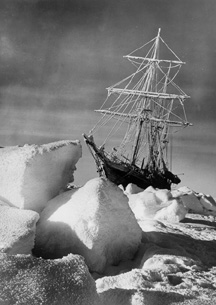Early Antarctic explorers Shackleton and Mawson were important figures in early Antarctic exploration. They shared some expeditions.
Shackleton had such confidence in Mawson that he instructed his crew that if anything happened to him, they should look to Mawson for leadership.
Ernest Shackleton (1872 - 1922)
The crew of 'Endurance'. ©Getty Images
Sir Ernest Henry Shackleton was a British explorer, born in Ireland. He was involved in many expeditions attempting to reach the South Pole.
His first voyage was with Captain Robert Falcon Scott and Edward Wilson in 1901-1904, when they travelled by sledge over the Ross Ice Shelf, almost reaching the South Pole.
In 1907-1909, Shackleton led a British Antarctic Expedition. Travelling by sledge, the expedition got to about 150 km short of the South Pole. During this expedition, they claimed the Victoria Land Plateau for Britain. Shackleton was knighted on his return home.
The Endurance caught in pack ice. ©Getty Images
Shackleton led another British Expedition (1914-16) that planned to cross Antarctica from the Weddell Sea to McMurdo Sound, a distance of about 3,200 km. Instead, they drifted at sea for 10 months, and their ship Endurance was crushed by pack ice in 1915. The crew escaped to Elephant Island. Shackleton and some of the crew travelled in a life boat for about 1,400 kms to get help, and then rescued the others.
On his last expedition to Antarctica, Shackleton died aboard ship and was buried on South Georgia Island. Sir Raymond Priestley, an explorer who accompanied Shackleton on the 1907-1913 Antarctic expedition, said, "For scientific leadership, give me Scott; for swift and efficient travel, Amundsen; but when you are in a hopeless situation, when there seems to be no way out, get on your knees and pray for Shackleton."
See photographs of the Endurance expedition taken by the Australian expedition photographer Frank Hurley :
Douglas Mawson (1882 – 1958)
Douglas Mawson was an Australian explorer. He was also a geologist and in 1906 he identified a radioactive mineral which he named Davidite after his friend T. W. Edgeworth David.
The Australian Antarctic Mawson Base, named in honour of Douglas Mawson. ©Getty Images
Mawson was a member of the British Antarctic Expedition in 1907-1909 which was led by Ernest Shackleton. On a three-man sledge trip, Mawson and two others travelled to the magnetic South Pole. Mawson was among the first to climb Antarctica's Mount Erebus.
He went on the scientific Australasian Antarctic Expedition in 1911-1914. During this expedition, Mawson went on a trip in which only he survived, walking 160 km alone, hauling his geological specimens on a sled. He wrote a book about this journey, 'The Home of the Blizzard'.
Summer visitors to Mawson's hut. ©Getty Images
In 1929-31 Mawson led the British, Australian, New Zealand Antarctic Research Expedition (called BANZARE), mapping the coastline of Antarctica and discovering MacRobertson land and Princess Elizabeth Land (which later became the Australian Antarctic Territory).
Mawson's hut at Cape Denison where he survived two winters still stands, but because of its remote location it deteriorated, unlike the huts of Scott and Shackleton on Ross Island where they are more easily reached for maintenance. Over the one hundred years it has been standing, snow and ice have damaged it. However, now the Mawson's Hut Foundation work through the very short Antarctic summers on repairs and restoration to its original condition.
How Mawson is remembered
©iStock
The Australian Antarctic Base is named after Douglas Mawson.
Mawson's image appeared on the Australian $100 bill between 1984 and 1991.
Read more about Mawson
Read other kidcyber pages about Antarctica






